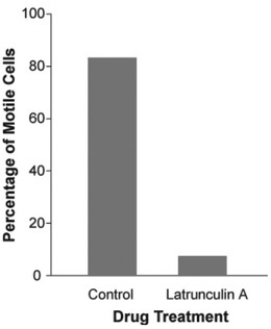Multiple Choice
Use the following information to answer the question(s) below.
The mechanism of cell crawling in protist species is not well defined. Pseudopodia extension involves interactions between actin and myosin (the same molecules that are involved in vertebrate muscle contraction) . However, prior to the study described below, no one had provided convincing data that actin and myosin were actually involved in cell crawling in protists. Anatomical studies had identified the cytoskeletal protein actin just below the surface of the cell membrane in several species of protist, but physiological studies had failed to show a functional link between actin, myosin, and cell crawling.
In a study by N. Poulsen et al. (Diatom gliding is the result of an actin-myosin motility system, Cell Motility and the Cytoskeleton 44 (1999) :23-22) , researchers tested whether motility in a particular species of diatom involves interactions between actin and myosin. 
-Refer to the study by Poulsen et al. and the accompanying figure. The data graphed in the figure could be an artifact if latrunculin A kills this species of diatoms (that is, that may be why the cells are not moving) . Which of the following would be the best evidence that latrunculin A is NOT killing the cells?
A) When the toxin was washed off the culture, the cells began to move again.
B) There were still a small percentage of motile cells in the culture treated with the toxin.
C) Most of the cells in the control were moving, indicating that they were alive.
D) When the toxin was applied to another species of diatom, 25 percent of them continued to move.
Correct Answer:

Verified
Correct Answer:
Verified
Q18: A particular species of protist has obtained
Q25: Amoeboid movement via long slender pseudopodia is
Q26: According to the endosymbiotic theory, why was
Q27: Protists from which of the following taxonomic
Q28: A snail-like, coiled, porous test (shell) of
Q32: By examining the phylogenetic tree diagrammed in
Q33: In examining a protist, you notice that
Q34: Which of the following eukaryotic lineages contains
Q47: All protists are<br>A) unicellular.<br>B) eukaryotic.<br>C) symbionts.<br>D) monophyletic.<br>E)
Q49: When a mosquito infected with Plasmodium first